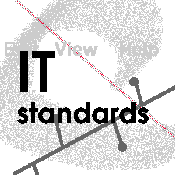
CORBA: Its Consortium, Competition, and Criticisms
by
Ellen Fischer
Introduction
In the 1990s, the use of objects and distributed computing has grown tremendously. New object-oriented programming languages, graphical user interfaces, and databases (Osher, p. 124) have been created and client-server software developed as the benefits of objects and distributed computing have been recognized. The Object Management Group's Common Object Request Broker Architecture is designed to combine these two paradigms, to realize the best of both worlds in allowing software to communicate through object interfaces. The greatest contribution of CORBA to this model is that CORBA allows different programming languages on different platforms to interrelate using a standard interface.
This issue of interconnecting different hardware and software platforms is one that is critical to most effectively utilizing the resources and information stores of many large companies. Clearly, interconnection and interoperation between networks of diverse companies depends on the resolution of this issue. But, these companies have the need to resolve this problem internally, also. Due to the expansion of their networks, or to the varied needs of departments, these companies may use several software packages programmed in different languages, running on a variety of operating systems in diverse locations -- the scenario for which CORBA was designed. CORBA provides a specification for a standard ‘language' for these programs to interact. Using CORBA, one program may call any other across the network. CORBA also provides a ‘directory service' so that the calling program can request an object without knowing the location of that object. These actions are accomplished by an Object Request Broker that complies with the CORBA specification.
The OMG bills CORBA as "Middleware that's Everywhere". Whether this proclamation is true in practical terms may be debatable, but CORBA is certainly "everywhere" in the trade press. The distributed object computing paradigm is taking hold, with CORBA as one of the front runners. CORBA is mentioned often, as the industry changes and grows quickly. This constant change makes it difficult to assess the current state of the CORBA specification, the OMG consortium and the product vendors and competitors.
The OMG was formed in May 1989 to begin producing specifications for a distributed object computing model. The first CORBA specification was released in 1991; the current version, CORBA 2.2, was released in February 1998. In this time, Java's Remote Method Invocation and Microsoft's Distributed Component Object Model have arisen as possible alternatives to CORBA. While RMI and DCOM may be considered competitors to CORBA, the OMG and its allies prefer to see them as complementary to CORBA, filling particular niches in the market. DCOM, though, is proving to be strong competition for CORBA and CORBA is facing general criticism as well.
The Work of the Object Management Group
CORBA Competition and Criticism
Ellen Fischer, March 30, 1998